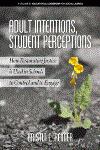
Adult Intentions, Student Perceptions
How Restorative Justice is Used in Schools to Control and to Engage
By:
Kristin E. Reimer, Monash University
A volume in the series: Educational Leadership for Social Justice. Editor(s): Jeffrey S. Brooks, Curtin University. Denise E. Armstrong, Brock University. Ira Bogotch, Florida Atlantic University. Sandra Harris, Lamar University. Whitney Sherman Newcomb, Virginia Commonwealth University. George Theoharis, Syracuse University.
Published 2018
Restorative justice (RJ) is an idea whose time may have finally arrived. Although the concept has ancient roots and the term has existed in Western societies since the 1970s, only recently has it gained general public recognition. In schools, RJ’s popularity is rising world-wide. In fact, education is the fastest growing area for the practice of RJ.
Despite an increasing number of schools embracing the approach, it is not clear what educational RJ practitioners are trying to achieve. Adult Intentions, Student Perceptions: How Restorative Justice is Used in Schools to Control and to Engage focuses on the use of RJ in one school in Scotland and one in Canada. While important to understand the intentions of educators in using RJ in schools, those aims must be examined alongside the actual impact that such practices have on students. RJ can be understood and experienced in dramatically different ways by those implementing it. For some, RJ is about creating an environment of and for student engagement that challenges traditional systems of discipline and facilitates learning. For others, RJ is simply another tool for solidifying compliance and meting out punishment, albeit in a kinder, gentler way. Adult Intentions, Student Perceptions provides the opportunity to delve deeply into the stories of two schools and the adults and young people who inhabit them, and consider the broad impact that differing educator understandings of RJ have on students.
Adult Intentions, Student Perceptions is a timely book for RJ advocates and critics alike. It challenges a common assumption of some RJ advocates that implementing RJ necessarily creates a classroom environment of social engagement (where students are empowered to engage with one another and think critically, and school relationships and hierarchies are transformed). The student experience relayed in this book shows that RJ can as readily be mobilized to create classroom environments of social control (where students are taught obedience and compliance, and authority and hierarchy are reinforced). Reimer argues that RJ, by itself, does not guarantee certain qualities of relationship, but RJ does allow us to examine relational qualities and ask questions of how school relationships are used to engage and/or control students.
CONTENTS
Series Editor’s Preface, Jeffrey S. Brooks. Foreword, Joel Westheimer. CHAPTER 1: Introduction: The Rise of Restorative Justice in Schools. CHAPTER 2: The Tensions Within Restorative Justice: A Continuum of Understandings. CHAPTER 3: Listening to the Voices in the Schools. CHAPTER 4: Rocky Creek: The Canadian School Story. CHAPTER 5: Rocky Creek Public School: Educator Intentions. CHAPTER 6: Rocky Creek Public School: Student Perceptions. CHAPTER 7: Royal Mills High School: The Scottish School Story. CHAPTER 8: Royal Mills High School: Educator Intentions. CHAPTER 9: Royal Mills High School: Pupil Perceptions. CHAPTER 10: Holding the Studies Side by Side. CHAPTER 11: Restorative Justice as a Window Into Relationships. References.
-
Paperback978-1-64113-504-7
Web price: $45.04 (Reg. 52.99)
-
Hardcover978-1-64113-505-4
Web price: $80.74 (Reg. 94.99)
- eBook978-1-64113-506-1

- EDU044000 - EDUCATION: Classroom Management
- EDU029000 - EDUCATION: TEACHING METHODS & MATERIALS: General
- EDU038000 - EDUCATION: Student Life & Student Affairs
-
 Crossing the Bridge of the Digital Divide
A Walk with Global Leaders
Crossing the Bridge of the Digital Divide
A Walk with Global Leaders
-
 Dear Gay, Lesbian, Bisexual, And Transgender Teacher
Letters Of Advice To Help You Find Your Way
Dear Gay, Lesbian, Bisexual, And Transgender Teacher
Letters Of Advice To Help You Find Your Way
-
 Envisioning a Critical Race Praxis in K-12 Education Through Counter-Storytelling
Envisioning a Critical Race Praxis in K-12 Education Through Counter-Storytelling
-
 Envisioning Critical Race Praxis in Higher Education Through Counter-Storytelling
Envisioning Critical Race Praxis in Higher Education Through Counter-Storytelling
-
 Restorative Practice Meets Social Justice
Un-Silencing the Voices of "At-Promise" Student Populations
Restorative Practice Meets Social Justice
Un-Silencing the Voices of "At-Promise" Student Populations
-
 School Leadership in a Diverse Society
Helping Schools Prepare all Students for Success (2nd Edition)
School Leadership in a Diverse Society
Helping Schools Prepare all Students for Success (2nd Edition)
-
 Within Reach
Providing Universal Access to the Four Pillars of Literacy
Within Reach
Providing Universal Access to the Four Pillars of Literacy

